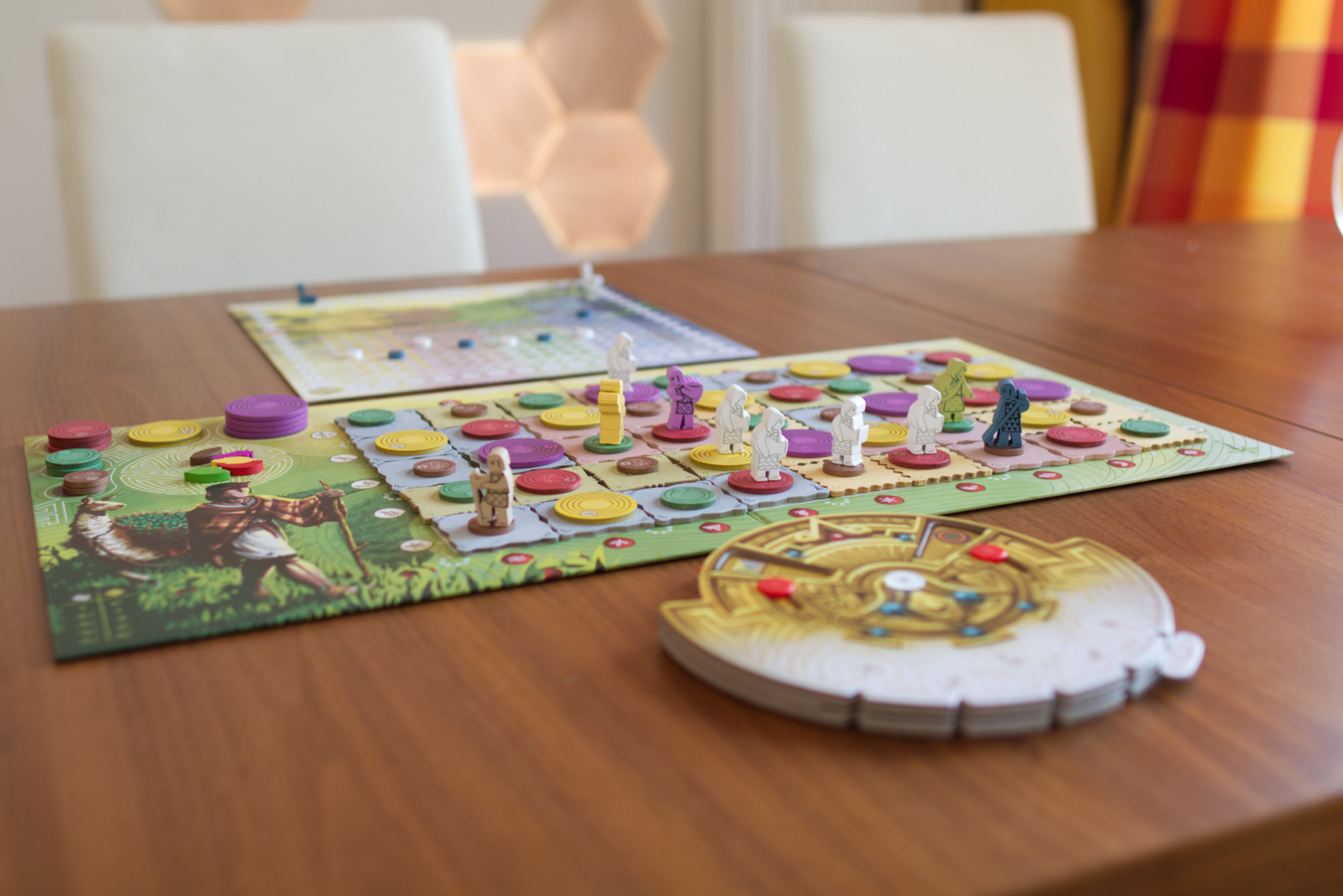While Kickstarter and crowdfunding in general has allowed a lot of small designers and independent publishers a chance to fulfil their dream and turn their ideas into products, it has also taken on a life of its own. After the initial rush, there seems to have been an extended period where games were mostly sold by the amount of plastic minis they contained or how enticing their table setup looked. Case in point: watch one of those intro videos at the top of a Kickstarter page and try to hold your breath until the thematic fluff and component presentation is over. Some of them even have stopped giving any game mechanic explanation at all! While that trend slowly, very slowly, seems to fade with gamers becoming more and more weary of this, checking out a new Kickstarter campaign always induces a healthy dose of mistrust in me nowadays. I guess I’ve played just too many games where the presentation looked great but the gameplay was somewhere between flawed and utterly broken.
Enter Tiwanaku. This is one of those cases where I intentionally sat out the Kickstarter. While the idea of a competitive minesweeper-meets-sudoku seemed intriguing, the execution seemed to be flawed. Was there really any game there, let a lone a none-solitaire one? Let’s find out…
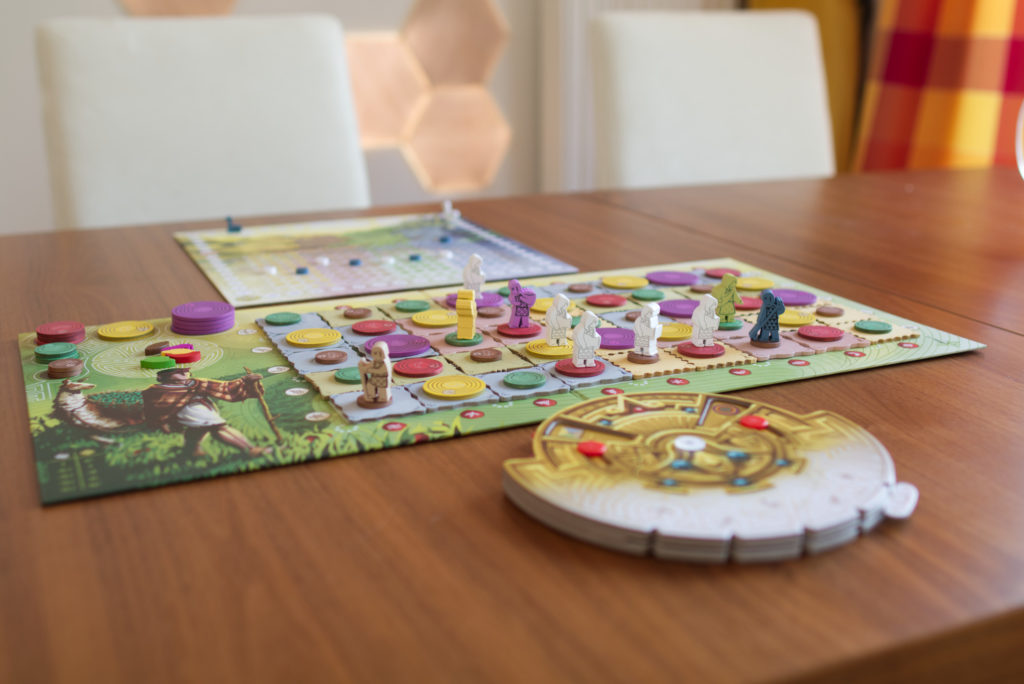
Setup
In Tiwanaku, players are exploring the countryside with their meeples to discover where regions of the same terrain type are (i.e. the colour of the space) and what types of crops need to be planted within them (discs numbered 1-5). There are a couple of steps to be done for setup, but it’s not overly burdensome. Primarily, players have to choose whether they want to play on a smaller 5×5 or full 9×5 grid and then choose one of the matching scenario discs. On the reverse, each discs shows the initial setup of already discovered fields and how many tiles of each terrain type will exist on this particular map. The front side contains terrain markings and numbers in an encoded way.
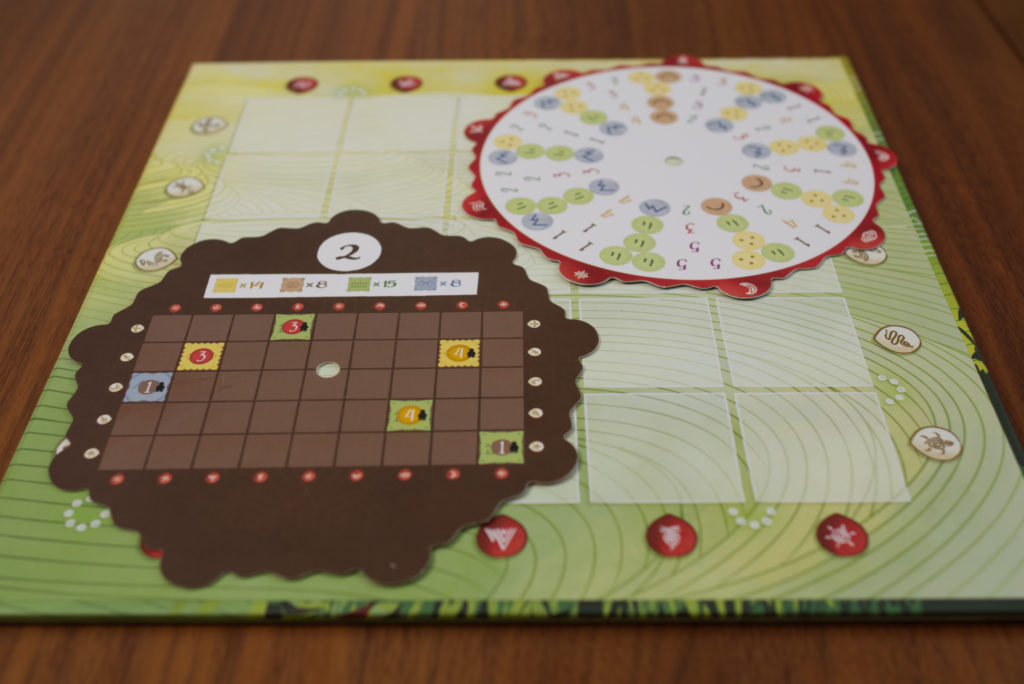
Players re-create the initial situation as indicated on the disc on the main board and get 5 meeples of their player color. They also place the coloured crop discs and a couple of small crop-shaped tokens into a supply area on the main board. Finally, they place four terrain type scoring markers on the scoring board as well as a very cute lama-shaped scoring marker (that unfortunately is so thin that it topples over all the time).
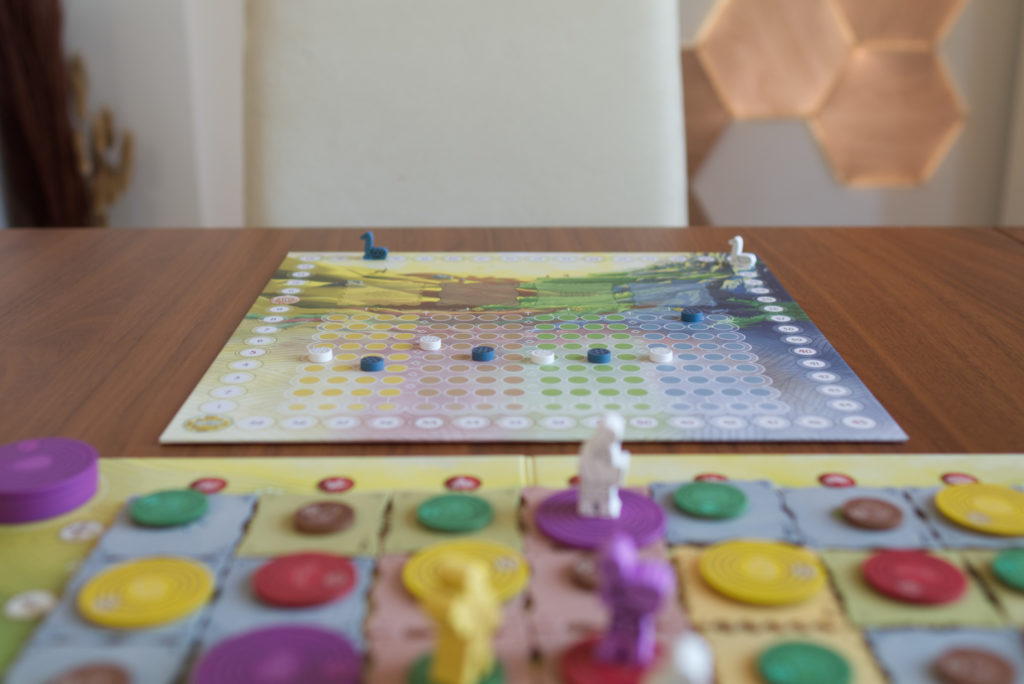
Note that the images show the wooden crop discs and terrain tiles that were an optional upgrade during the campaign. While the tactility of the wooden pieces is nice, their colours are a bit washed out compared to the cardboard version and I think I would rather have those if my second hand copy wouldn’t have included the upgrade already. Another thing to note is that the box contains only 8 small grid discs (3 of them being stretch goals) and 22 large grid discs (7 of them being stretch goals). There was also an add on for more discs. So depending on which edition you buy, there might be a rather limited number of discs available.
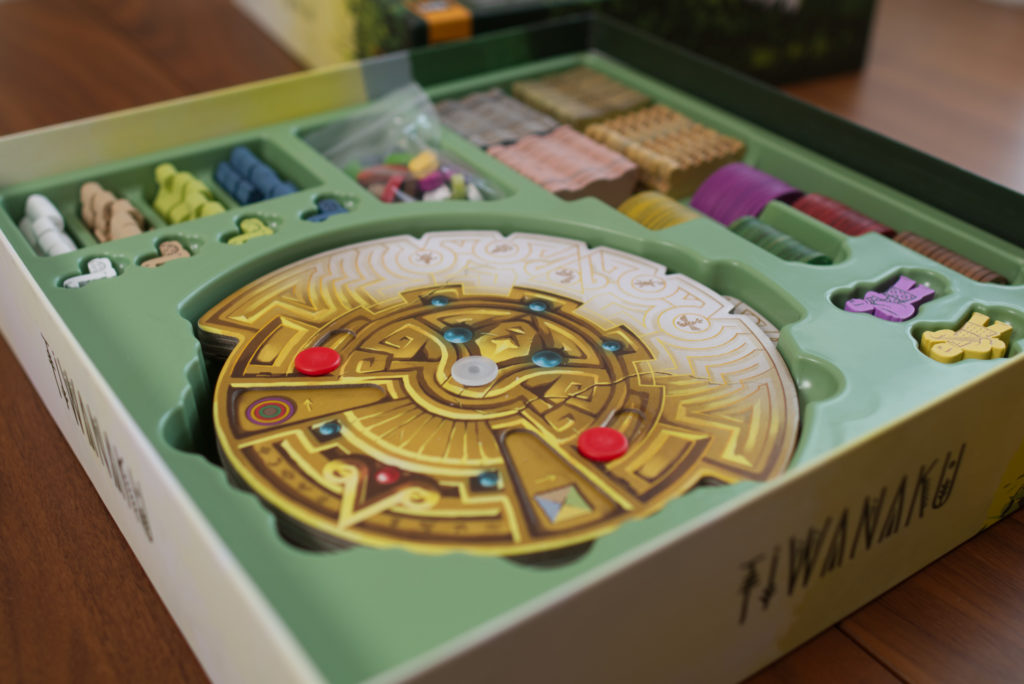
To complete setup, the chose disc is slot into the party piece of the game, the Pachama wheel, and fastened by pushing the plastic bolt through its middle.
The Turn
During a player’s turn, they can either move one of their meeples or do a prediction. Let’s focus on movement for now as that will be what players do in the initial phase of the game. Movement entails either having a new meeple enter the board from one of the sides or moving an already placed meeple one space horizontally or vertically. If the meeple steps on a space that already contains both a terrain tile and a crop disc, it continues its movement. Meeples are however not allowed to move through any other meeples, regardless of which player they belong to.
Once a meeple steps on a field without a crop disc, its movement ends. If the space does not yet contain a terrain tile, the player rotates the disc inside the prediction wheel such that the symbol the needle points to matches the one shown on the column of the main board. The slider on the bottom of the wheel on the other hand selects the row the meeple is standing in. Once this is done, the red plastic button on the left side is slid down, revealing the terrain tile of that space in the left window. For those of us that are old enough, this kind of brings back memories of the old Monkey Island copy protection disc. It works well except for two small issues: for one, player’s are always tempted on inadvertently also open the right window revealing the crop number. For the other, the terrain colour shown inside the window is sometimes difficult to see and a number of people confused terrain types. If this happens, that can of course screw up the whole game. While there are symbols, the symbols do not perfectly match the ones printed on the terrain tile. For example, the red hill tiles show a single arch on the disc but a longer wavy line on the actual tile.
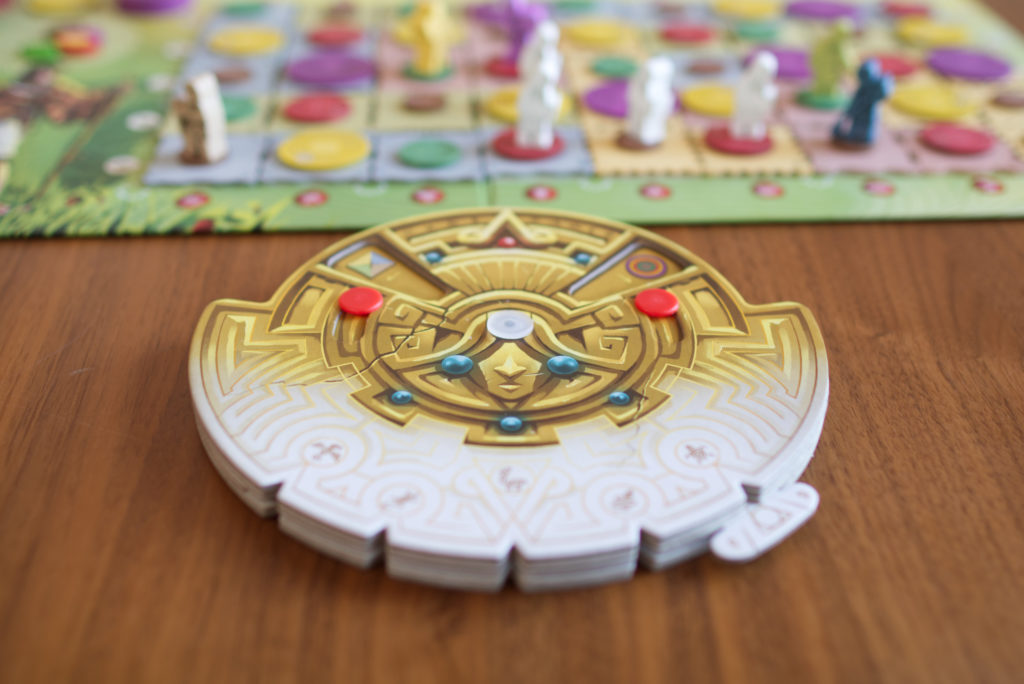
The player then moves their terrain marker of that type one step up on the scoring board and receive as many points as markers they have on the same level. This sounds more complicated than it is. In essence, it is more lucrative to discover terrain types in an equal fashion.
The other option for a player’s turn is to predict what number (=crop type / disc) the square contains. So how is this done? There are a number of rules that limit what type of terrain and what numbered disc can be where. First, a connected group of tiles of the same terrain tile can be at most five in size. Further, no two tiles of the same type can be diagonal of each other unless they belong to the same connected group. And finally, as specified during setup, the number of tiles available for each type is known to all players (e.g. there will only be 10 mountains).
With regard to the crop discs, similar rules exist: in each connected group of tiles of the same type, each number exists only once, from one to the number of tiles in that group (e.g. 1-4 in a four-tile group). Finally, no two discs of the same number can be next to each other, neither horizontally, vertically, nor vertically.
If a player guesses correctly, they gain VP equal to the value of the disc and place it on the board. They also get a small wooden crop token representing that crop (a set of which can be exchanged for additional VP) and are allowed to continue guessing other squares their meeples are standing on. If they guess incorrectly, they instead lose VP equal to the disc’s value but also place it on the square. Either way, the square is now completely explored and will be one more clue all players can use to deduce what other terrain types and crop discs might be in its surrounding.
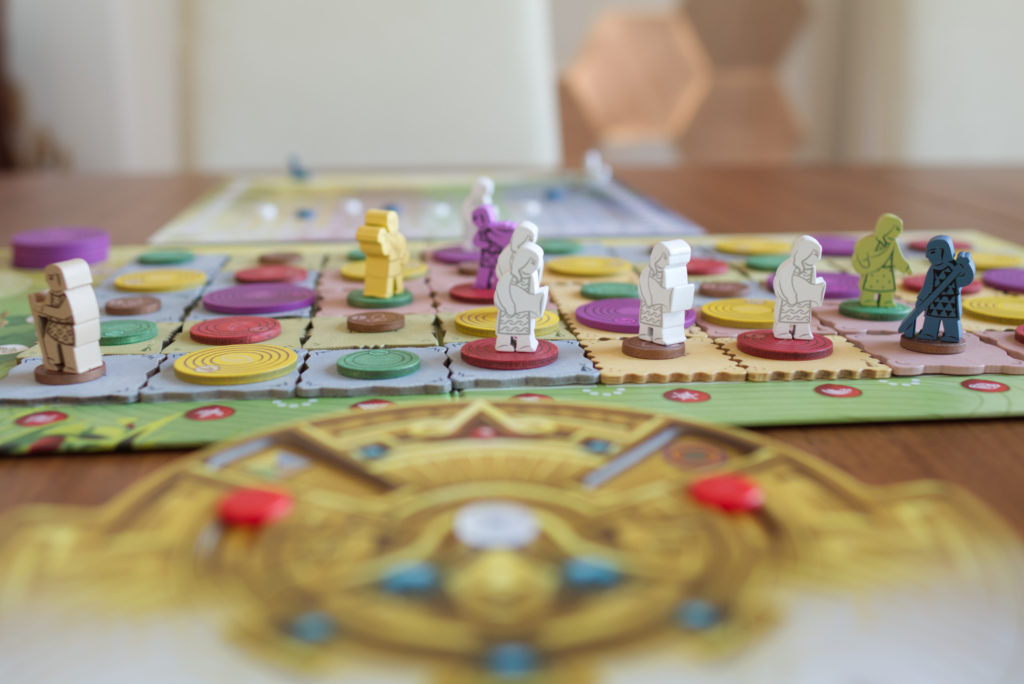
Game End
Interestingly, the game does not end when all squares contain a crop disc but as soon as the last terrain tile is placed. This adds pressure for all players to work efficiently and not waste turns predicting just a single square or moving meeples on squares that already have their terrain type discovered. A final round of predictions is done and whoever has collected the most VP wins.
Solo & Cooperative Mode
The solo mode is played against an automa consisting of five different coloured meeples. Each terrain tile contains on its reverse a coloured arrow. When the human player moves and steps on a terrain tile without a crop disc or discovers a new tile, the arrow indicates the colour of automa meeple and direction of their movement. In contrast to the human player, the automa automatically discovers both the terrain type and crop value when stepping on an empty field and is allowed to move through other meeples. It therefore acts as both a timer and clue giver, collecting points while it is exploring. The solo mode works well, though I had to reduce my own number of meeples from five to four to make it more challenging after a few plays. It is a bit odd that the automa will not claim spaces where the terrain tile has been revealed but that do not yet contain a crop disc as this allows the human player to leave high-valued squares without any danger of being snatched up. However, doing so is wasting time and the automa will continue to discover new squares, bringing the game’s end closer and closer.
The other tweak is that in solo mode, doing a prediction forces you to do them for all of your meeples. So you either have to take risks and just guess or waste turns and move your people to squares where you are sure to know the correct number.
There is also a cooperative multiplayer mode, but I haven’t had a chance to test it out yet.
Conclusion
As I said in the introduction, I didn’t back this game and only picked up a second hand copy when Jamey Stegmaier of Stonemaier Games posted about Tiwanaku on Instagram. On paper, Tiwanaku shouldn’t work nearly as well as it does in real life. It sounds like a cheap solo puzzle you might find in a newspaper that someone for some reason tried to blow up into a board game. And rest assured, if you don’t like puzzles like Ricochet Robots, this won’t be for you. But if you do enjoy them, it might.
Tiwanaku works in different phases. Initially, players set out to discover terrain tiles both in a way that they maximise their direct points (e.g. discover one of each colour before discovering the second one of each colour) while gaining insights about the underlying distribution. But the interesting part is the positional play that is at work. You want to explore tiles in a way such that you have a high probability of your meeples ending up on a four or five, even though you might not know yet which one it is exactly. You also want to block your opponents’ meeples from being able to reach interesting squares such that they for example have to keep exploring grass lands when they would need mountains to achieve more VP.
At a a certain point, the game dynamic tips and there is enough information to deduce numbers or pressure to not waste time and simply guess. But again, this needs to be done in a way that you can benefit from the gained information the most with all your meeples in position to move into lucrative neighbouring spaces that suddenly becomes obvious. And above all, there is the set collection aspect giving you an incentive to discover crop discs in an equal manor as well. If you have three different crop markers (e.g. a 1, 3, and 5), those can be exchanged for 3 points. But if you manage to get all five, that’s a whopping 10 points. So you’re not only trying to a) guess correctly, b) be in a position where there is a 4-5 instead of a 1-2, c) be in a good position for future moves, no, you also have to make sure you find a square containing that one number you need to complete the set you have been collecting.
Is this the best puzzle you have ever done? No. But it works way better than you might think. I’ve played it solo, 2p, and 3p, and all players so far have enjoyed the experience. The theming is lovely and approachable, the artwork colourful. There is also skill in this game, with experienced players scoring way better than newcomers. A single play takes approx 30-45min, so it has a nice filler-length for experienced players and stays simple enough for new players. But all definitely have to be in the mood for a sudoku-style deduction problem, otherwise things will get frustrating – or plain boring – quickly.
Finally, I recommend getting the retail edition and not the Kickstarter one for two reasons: 1) this game only works at its cheaper price point (this definitely is not a game you will want to spend 60-100 Euros on) and 2) the cardboard terrain tiles and crop discs are much more contrasty. I was quite disappointed to see the washed out colours of the wooden “premium” components and if you opted for them, you didn’t receive the cardboard ones. The biggest negative is probably the number of discs included in the game. The smaller grid scenario discs are not compatible with the solo mode and if you plan on playing this regularly, getting the additional discs is something to seriously consider. A BGG user has posted a scenario generator, but it is completely online and something is lost by not handling the prediction wheel as this is a large part of the playing experience.
So to sum this one up, I would say “call me pleasantly surprised”. If you enjoy playing solo or have other people that also enjoy sudoku-style deduction puzzles, this is a nice one. It’s not overly complex, but the positional play is interesting and there can be moments where suddenly everything becomes clear and you can perfectly deduce half the board. Don’t expect the most interesting puzzle you have ever done, but it has hit my table way more often than I thought it would.
